stop start VOLVO XC60 TWIN ENGINE 2019 User Guide
[x] Cancel search | Manufacturer: VOLVO, Model Year: 2019, Model line: XC60 TWIN ENGINE, Model: VOLVO XC60 TWIN ENGINE 2019Pages: 695, PDF Size: 14.96 MB
Page 228 of 695
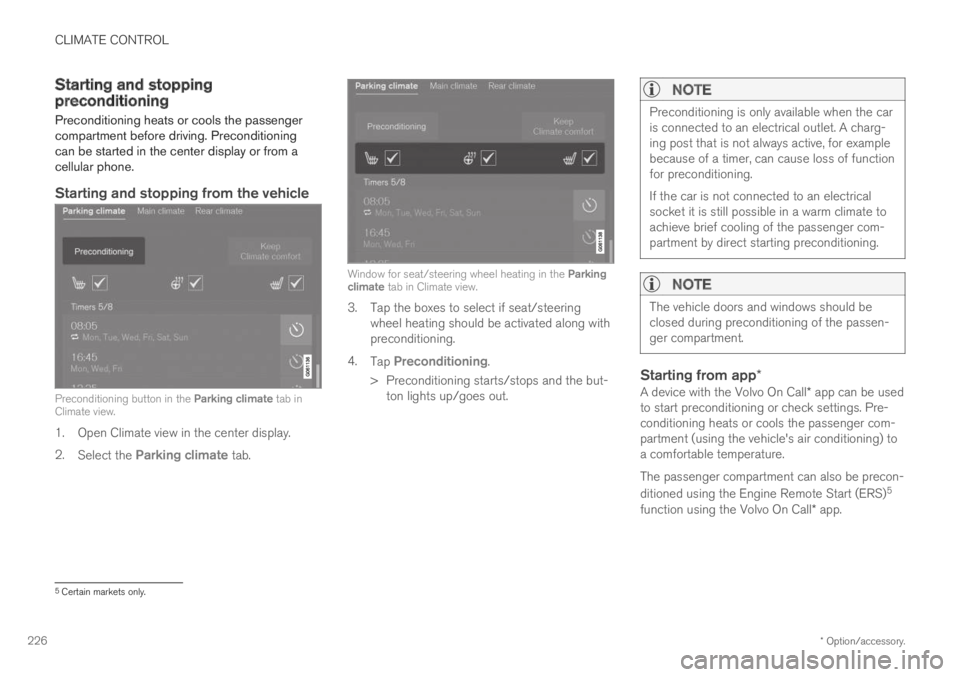
CLIMATE CONTROL
* Option/accessory.226
Starting and stoppingpreconditioning
Preconditioning heats or cools the passengercompartment before driving. Preconditioningcan be started in the center display or from acellular phone.
Starting and stopping from the vehicle
Preconditioning button in the Parking climate tab inClimate view.
1. Open Climate view in the center display.
2.Select the Parking climate tab.
Window for seat/steering wheel heating in the Parkingclimate tab in Climate view.
3. Tap the boxes to select if seat/steeringwheel heating should be activated along withpreconditioning.
4.Tap Preconditioning.
>Preconditioning starts/stops and the but-ton lights up/goes out.
NOTE
Preconditioning is only available when the caris connected to an electrical outlet. A charg-ing post that is not always active, for examplebecause of a timer, can cause loss of functionfor preconditioning.
If the car is not connected to an electricalsocket it is still possible in a warm climate toachieve brief cooling of the passenger com-partment by direct starting preconditioning.
NOTE
The vehicle doors and windows should beclosed during preconditioning of the passen-ger compartment.
Starting from app *
A device with the Volvo On Call* app can be usedto start preconditioning or check settings. Pre-conditioning heats or cools the passenger com-partment (using the vehicle's air conditioning) toa comfortable temperature.
The passenger compartment can also be precon-
ditioned using the Engine Remote Start (ERS)5
function using the Volvo On Call* app.
5Certain markets only.
Page 251 of 695
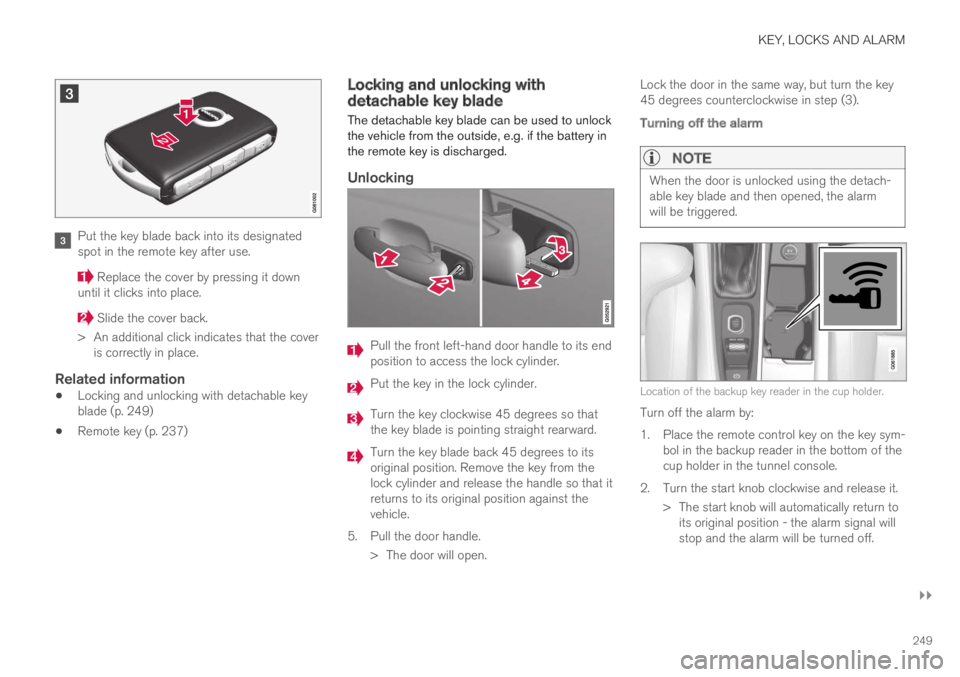
KEY, LOCKS AND ALARM
}}
249
Put the key blade back into its designatedspot in the remote key after use.
Replace the cover by pressing it downuntil it clicks into place.
Slide the cover back.
>An additional click indicates that the coveris correctly in place.
Related information
Locking and unlocking with detachable keyblade (p. 249)
Remote key (p. 237)
Locking and unlocking withdetachable key blade
The detachable key blade can be used to unlockthe vehicle from the outside, e.g. if the battery inthe remote key is discharged.
Unlocking
Pull the front left-hand door handle to its endposition to access the lock cylinder.
Put the key in the lock cylinder.
Turn the key clockwise 45 degrees so thatthe key blade is pointing straight rearward.
Turn the key blade back 45 degrees to itsoriginal position. Remove the key from thelock cylinder and release the handle so that itreturns to its original position against thevehicle.
5.Pull the door handle.
> The door will open.
Lock the door in the same way, but turn the key45 degrees counterclockwise in step (3).
Turning off the alarm
NOTE
When the door is unlocked using the detach-able key blade and then opened, the alarmwill be triggered.
Location of the backup key reader in the cup holder.
Turn off the alarm by:
1.Place the remote control key on the key sym-bol in the backup reader in the bottom of thecup holder in the tunnel console.
2. Turn the start knob clockwise and release it.
> The start knob will automatically return toits original position - the alarm signal willstop and the alarm will be turned off.
Page 278 of 695
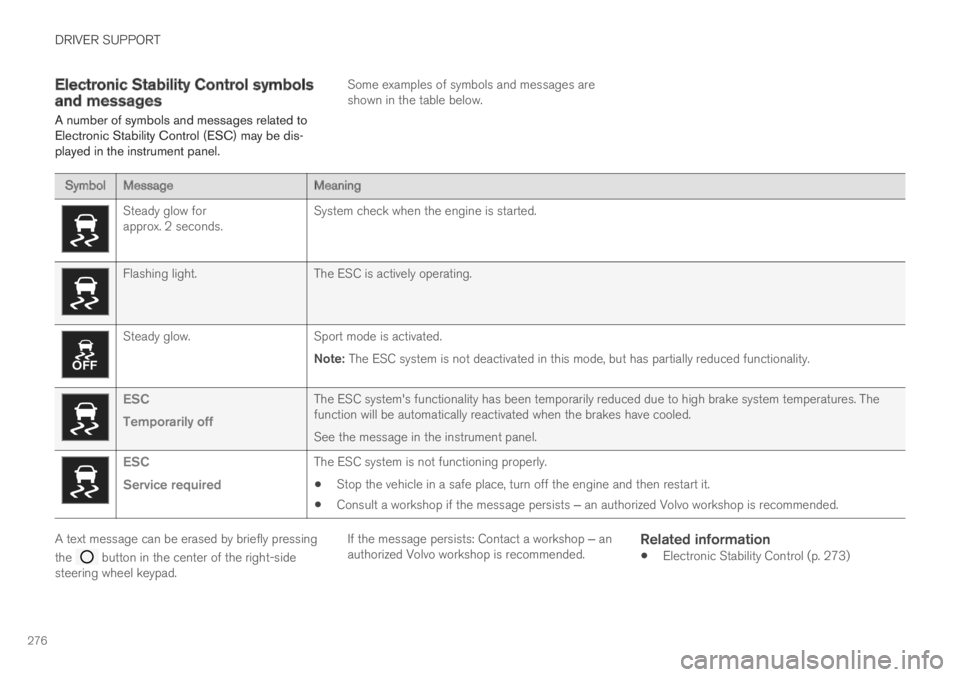
DRIVER SUPPORT
276
Electronic Stability Control symbolsand messages
A number of symbols and messages related toElectronic Stability Control (ESC) may be dis-played in the instrument panel.
Some examples of symbols and messages areshown in the table below.
SymbolMessageMeaning
Steady glow forapprox. 2 seconds.System check when the engine is started.
Flashing light.The ESC is actively operating.
Steady glow.Sport mode is activated.
Note: The ESC system is not deactivated in this mode, but has partially reduced functionality.
ESC
Temporarily off
The ESC system's functionality has been temporarily reduced due to high brake system temperatures. Thefunction will be automatically reactivated when the brakes have cooled.
See the message in the instrument panel.
ESC
Service required
The ESC system is not functioning properly.
Stop the vehicle in a safe place, turn off the engine and then restart it.
Consult a workshop if the message persists ‒ an authorized Volvo workshop is recommended.
A text message can be erased by briefly pressing
the button in the center of the right-sidesteering wheel keypad.
If the message persists: Contact a workshop ‒ anauthorized Volvo workshop is recommended.
Related information
Electronic Stability Control (p. 273)
Page 405 of 695
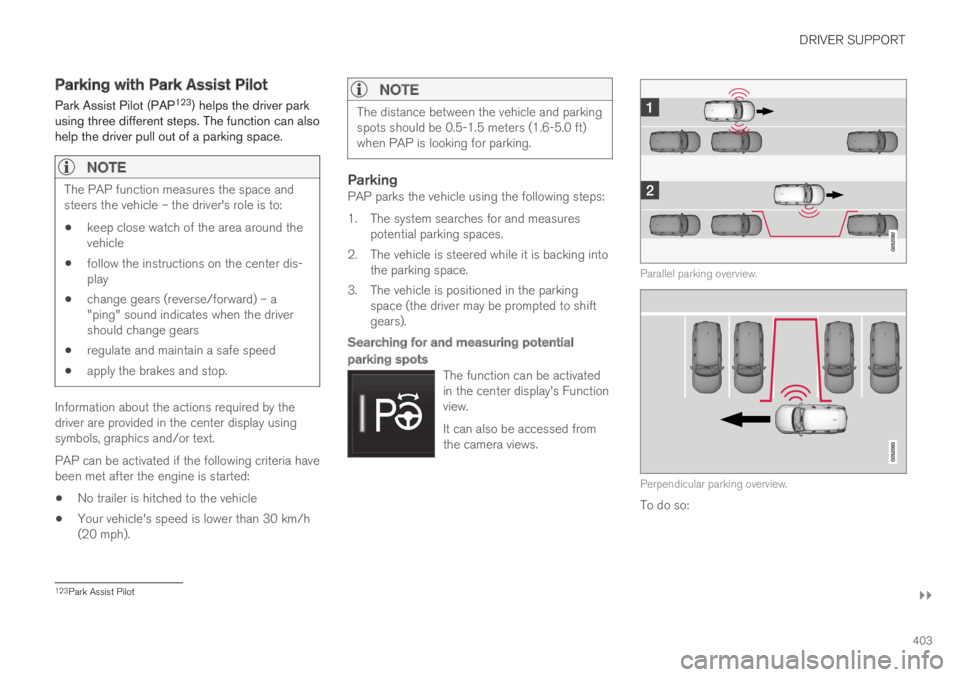
DRIVER SUPPORT
}}
403
Parking with Park Assist Pilot
Park Assist Pilot (PAP123) helps the driver parkusing three different steps. The function can alsohelp the driver pull out of a parking space.
NOTE
The PAP function measures the space andsteers the vehicle – the driver's role is to:
keep close watch of the area around thevehicle
follow the instructions on the center dis-play
change gears (reverse/forward) – a"ping" sound indicates when the drivershould change gears
regulate and maintain a safe speed
apply the brakes and stop.
Information about the actions required by thedriver are provided in the center display usingsymbols, graphics and/or text.
PAP can be activated if the following criteria havebeen met after the engine is started:
No trailer is hitched to the vehicle
Your vehicle's speed is lower than 30 km/h(20 mph).
NOTE
The distance between the vehicle and parkingspots should be 0.5-1.5 meters (1.6-5.0 ft)when PAP is looking for parking.
Parking
PAP parks the vehicle using the following steps:
1. The system searches for and measurespotential parking spaces.
2. The vehicle is steered while it is backing intothe parking space.
3. The vehicle is positioned in the parkingspace (the driver may be prompted to shiftgears).
Searching for and measuring potential
parking spots
The function can be activatedin the center display's Functionview.
It can also be accessed fromthe camera views.
Parallel parking overview.
Perpendicular parking overview.
To do so:
123Park Assist Pilot
Page 414 of 695

HYBRID INFORMATION
412
General information about TwinEngine
Twin Engine vehicles are driven just like anyother vehicle, but certain functions differ from avehicle powered exclusively by gasoline. Theelectric motor powers the vehicle primarily at lowspeeds; the gasoline engine is used at higherspeeds or during more active driving.
The instrument panel displays Twin Engine-spe-cific information - charging information, selecteddrive mode, distance to discharged battery andhybrid battery charge level.
Different drive modes can be selected while driv-ing, e.g. electric power only or, if more power isneeded, a combination of electric and gasolinepower. The vehicle calculates the optimal combi-nation of driveability, driving experience, environ-mental impact and fuel economy for the selecteddrive mode.
In order to function optimally, the hybrid battery(and its electrical drive systems) and the gasolineengine (and its drive systems) must be at thecorrect operating temperature. Battery capacitycan be considerably reduced if the battery is toocold or too hot. Preconditioning prepares thevehicle's drive systems and passenger compart-ment before driving to help reduce both wear andenergy consumption. It also helps increase thehybrid battery's range.
The hybrid battery which powers the electricmotor is recharged using the charging cable. It
can also be recharged during light braking andthrough engine braking in gear position B. Thecombustion engine can also help recharge thehybrid battery.
Important
No electrical current
Keep in mind that if there is no electrical currentto the vehicle, i.e. the ignition is switched off orthe start battery is discharged, certain functionssuch as brakes, power steering, etc. will not work.
WARNING
If the vehicle does not have electrical currentand both the electric motor and the gasolineengine are switched off, the brakes cannot beused to stop the vehicle.
Towing not permitted
Never tow a Twin Engine vehicle behind anothervehicle, as this could damage the electric motor.
Exterior engine noise
WARNING
Please be aware that there is no sound fromthe engine when the vehicle is being poweredby the electric motor and it may be difficult todetect by children, pedestrians, cyclists andanimals. This is especially true at low speeds.
High-voltage electrical current
WARNING
A number of electrical components in TwinEngine Plug-in Hybrid vehicles use high-volt-age current and can be extremely dangerousif handled incorrectly. These components andany orange wiring in the vehicle may only behandled by trained and qualified Volvo servicetechnicians.
Do not touch anything that is not clearly descri-bed in this Owner's Manual.
Related information
Charging the hybrid battery (p. 413)
Hybrid gauge (p. 87)
Drive modes (p. 450)
Starting and stopping preconditioning(p. 226)
Hybrid battery (p. 629)
Factors affecting electric motor range(p. 465)
Page 416 of 695
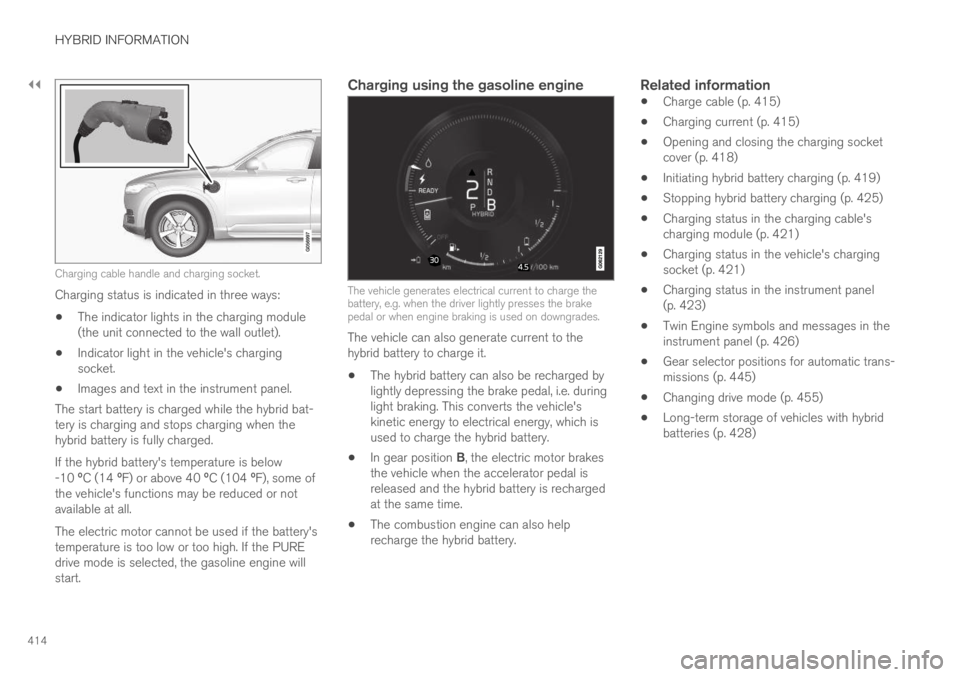
||
HYBRID INFORMATION
414
Charging cable handle and charging socket.
Charging status is indicated in three ways:
The indicator lights in the charging module(the unit connected to the wall outlet).
Indicator light in the vehicle's chargingsocket.
Images and text in the instrument panel.
The start battery is charged while the hybrid bat-tery is charging and stops charging when thehybrid battery is fully charged.
If the hybrid battery's temperature is below-10 ºC (14 ºF) or above 40 ºC (104 ºF), some ofthe vehicle's functions may be reduced or notavailable at all.
The electric motor cannot be used if the battery'stemperature is too low or too high. If the PUREdrive mode is selected, the gasoline engine willstart.
Charging using the gasoline engine
The vehicle generates electrical current to charge thebattery, e.g. when the driver lightly presses the brakepedal or when engine braking is used on downgrades.
The vehicle can also generate current to thehybrid battery to charge it.
The hybrid battery can also be recharged bylightly depressing the brake pedal, i.e. duringlight braking. This converts the vehicle'skinetic energy to electrical energy, which isused to charge the hybrid battery.
In gear position B, the electric motor brakesthe vehicle when the accelerator pedal isreleased and the hybrid battery is rechargedat the same time.
The combustion engine can also helprecharge the hybrid battery.
Related information
Charge cable (p. 415)
Charging current (p. 415)
Opening and closing the charging socketcover (p. 418)
Initiating hybrid battery charging (p. 419)
Stopping hybrid battery charging (p. 425)
Charging status in the charging cable'scharging module (p. 421)
Charging status in the vehicle's chargingsocket (p. 421)
Charging status in the instrument panel(p. 423)
Twin Engine symbols and messages in theinstrument panel (p. 426)
Gear selector positions for automatic trans-missions (p. 445)
Changing drive mode (p. 455)
Long-term storage of vehicles with hybridbatteries (p. 428)
Page 417 of 695

HYBRID INFORMATION
}}
415
Charging current
Charging current is used to charge the hybridbattery and precondition the vehicle. Charging isperformed by connecting a charging cablebetween the vehicle's charging socket and a120/240 V electrical socket (alternating cur-rent).
When the charging cable is activated, a messagewill be displayed in the instrument panel and anindicator light in the vehicle's charging socket willilluminate. Charging current is primarily used forbattery charging, but is also used for precondi-tioning. The vehicle's start battery is chargedalong with the hybrid battery.
CAUTION
Never detach the charging cable from the120/240 V outlet (AC, alternating current)while charging is in progress – the120/240 V outlet could be damaged in suchcircumstances. Always interrupt charging firstand then disconnect the charging cable – firstfrom the vehicle's charging socket and thenfrom the 120/240 V outlet.
NOTE
In extremely cold or hot weather, part ofthe charging current is used to heat/coolthe hybrid battery and the passengercompartment, resulting in a longer charg-ing time.
The charging time is longer if precondi-tioning has been selected. The timerequired depends primarily on the ambi-ent temperature.
Fuse
There are normally several 120/240 V powerconsumers in one fuse circuit, which means thatmore than one power consumer (e.g. lighting,vacuum cleaner, electric drill, etc.) may use thesame fuse.
Related information
Charge cable (p. 415)
Charging status in the instrument panel(p. 423)
Charging status in the vehicle's chargingsocket (p. 421)
Starting and stopping preconditioning(p. 226)
Stopping hybrid battery charging (p. 425)
Charge cable
The charging cable is used to recharge yourvehicle's hybrid battery.
The charging cable is stored in a storage compartmentunder the cargo compartment floor.
WARNING
Only use the charging cable provided withyour vehicle or a replacement cable pur-chased from a Volvo retailer.
Specifications, charging cable
ComplianceSAE J1772
Ambient tempera-ture-32 ºC to 50 ºC (-25 ºFtill 122 ºF)
Page 422 of 695
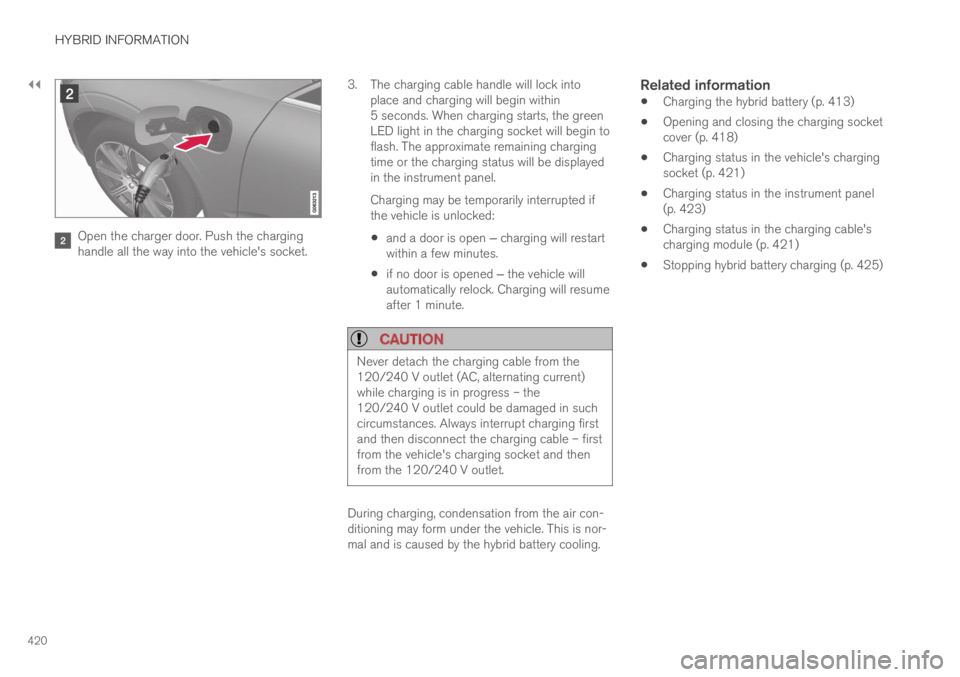
||
HYBRID INFORMATION
420
Open the charger door. Push the charginghandle all the way into the vehicle's socket.
3.The charging cable handle will lock intoplace and charging will begin within5 seconds. When charging starts, the greenLED light in the charging socket will begin toflash. The approximate remaining chargingtime or the charging status will be displayedin the instrument panel.
Charging may be temporarily interrupted ifthe vehicle is unlocked:
and a door is open ‒ charging will restartwithin a few minutes.
if no door is opened ‒ the vehicle willautomatically relock. Charging will resumeafter 1 minute.
CAUTION
Never detach the charging cable from the120/240 V outlet (AC, alternating current)while charging is in progress – the120/240 V outlet could be damaged in suchcircumstances. Always interrupt charging firstand then disconnect the charging cable – firstfrom the vehicle's charging socket and thenfrom the 120/240 V outlet.
During charging, condensation from the air con-ditioning may form under the vehicle. This is nor-mal and is caused by the hybrid battery cooling.
Related information
Charging the hybrid battery (p. 413)
Opening and closing the charging socketcover (p. 418)
Charging status in the vehicle's chargingsocket (p. 421)
Charging status in the instrument panel(p. 423)
Charging status in the charging cable'scharging module (p. 421)
Stopping hybrid battery charging (p. 425)
Page 423 of 695
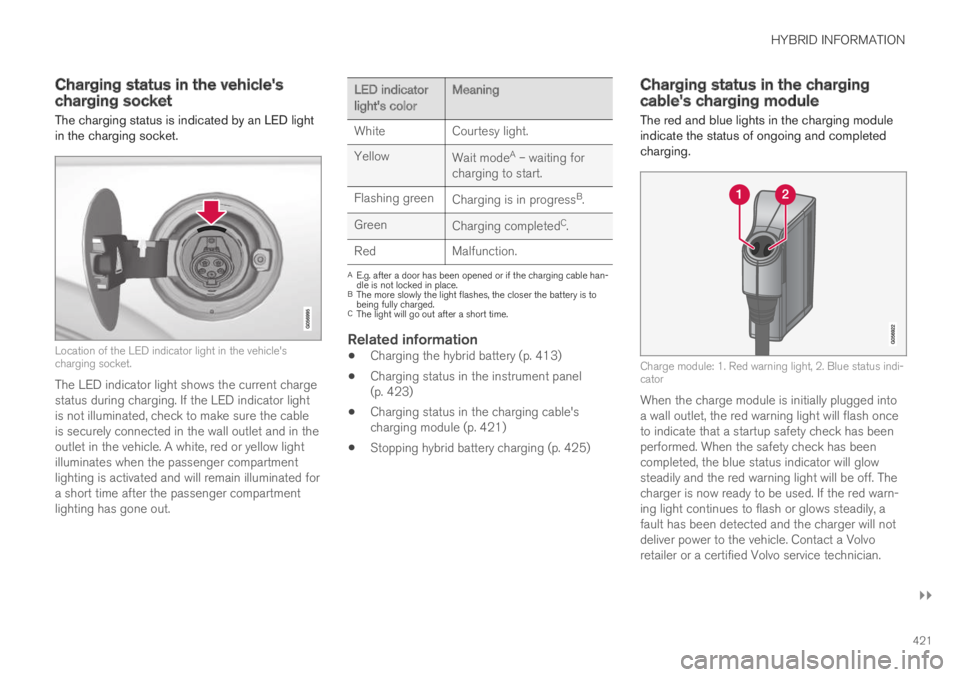
HYBRID INFORMATION
}}
421
Charging status in the vehicle'scharging socket
The charging status is indicated by an LED lightin the charging socket.
Location of the LED indicator light in the vehicle'scharging socket.
The LED indicator light shows the current chargestatus during charging. If the LED indicator lightis not illuminated, check to make sure the cableis securely connected in the wall outlet and in theoutlet in the vehicle. A white, red or yellow lightilluminates when the passenger compartmentlighting is activated and will remain illuminated fora short time after the passenger compartmentlighting has gone out.
LED indicatorlight's colorMeaning
WhiteCourtesy light.
YellowWait modeA – waiting forcharging to start.
Flashing greenCharging is in progressB.
GreenCharging completedC.
RedMalfunction.
AE.g. after a door has been opened or if the charging cable han-dle is not locked in place.BThe more slowly the light flashes, the closer the battery is tobeing fully charged.CThe light will go out after a short time.
Related information
Charging the hybrid battery (p. 413)
Charging status in the instrument panel(p. 423)
Charging status in the charging cable'scharging module (p. 421)
Stopping hybrid battery charging (p. 425)
Charging status in the chargingcable's charging module
The red and blue lights in the charging moduleindicate the status of ongoing and completedcharging.
Charge module: 1. Red warning light, 2. Blue status indi-cator
When the charge module is initially plugged intoa wall outlet, the red warning light will flash onceto indicate that a startup safety check has beenperformed. When the safety check has beencompleted, the blue status indicator will glowsteadily and the red warning light will be off. Thecharger is now ready to be used. If the red warn-ing light continues to flash or glows steadily, afault has been detected and the charger will notdeliver power to the vehicle. Contact a Volvoretailer or a certified Volvo service technician.
Page 426 of 695
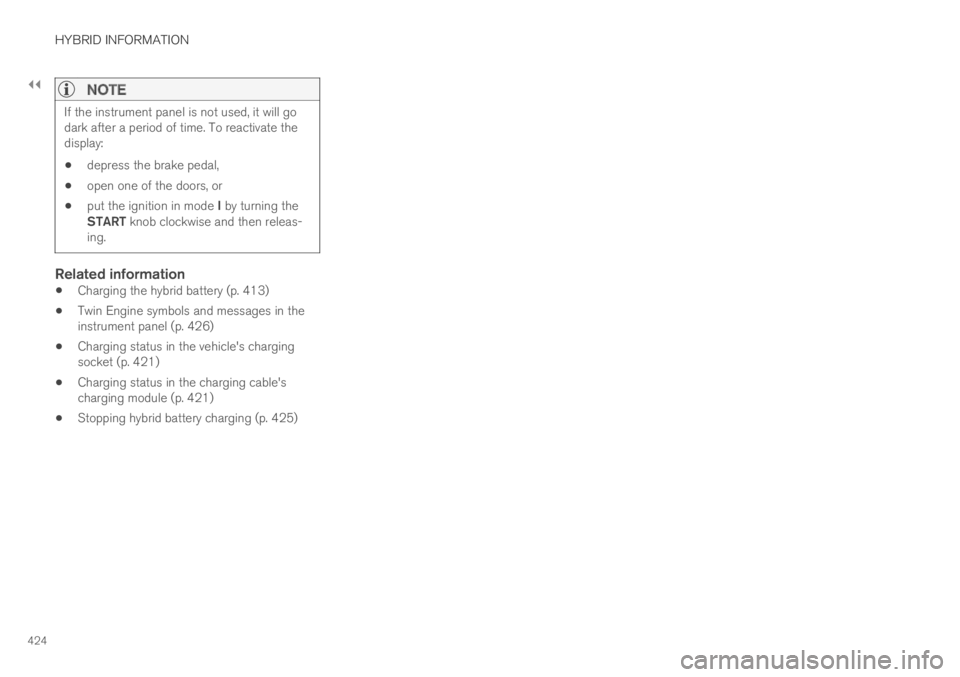
||
HYBRID INFORMATION
424
NOTE
If the instrument panel is not used, it will godark after a period of time. To reactivate thedisplay:
depress the brake pedal,
open one of the doors, or
put the ignition in mode I by turning theSTART knob clockwise and then releas-ing.
Related information
Charging the hybrid battery (p. 413)
Twin Engine symbols and messages in theinstrument panel (p. 426)
Charging status in the vehicle's chargingsocket (p. 421)
Charging status in the charging cable'scharging module (p. 421)
Stopping hybrid battery charging (p. 425)